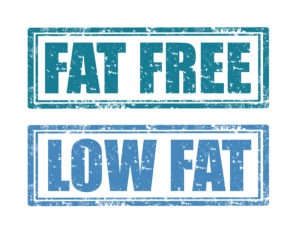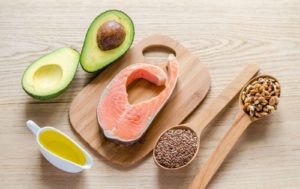
It's 2017 and we've come a long way as far as our understanding of fats. Today we're a smarter nation, I hope, and we now know it's more about sugar and carbohydrate regulation than it is about eliminating fats. That means at the very least questioning those "Low-Fat" and " No-Fat" labels, because fat is an important piece of our dietary puzzle. Truth be told, most of those claims mean that something else, usually processed and and artificial has been added. After all, companies want their products to sell, and flavor has to come from somewhere. So, if you're not eating the fat, then ask yourself, "What ARE you eating?"
We often hear the term "healthy fats" but what exactly does that mean, and why are some considered bad? Well, to understand this, we need to dive a little into the makeup of the different types of fats. Fat is one of the three essential macronutrients we need, the others being protein and carbs. It helps regulate our body's temperature, maintain our skin and tissue, provides energy, and is necessary to transports certain vitamins such as A, D, E, K around the body. The two main types are saturated and unsaturated.
Saturated refers to hydrogen. When we see "hydrogenated" on a product it means it was pumped with hydrogen, usually to add flavor and texture to foods. Saturated is also solid at room temperature. You could have guessed it, but these are the fats in meats and cheeses as well as palm and coconut. However, not all saturated fats are "bad." In fact in a perfect world 1/3 of our daily fat intake should come from naturally sourced saturated fats. These fats should be limited, but do have their benefits. Both meat and cheese are high in the Omega-6 CLA, or conjugated linoleic acid. This is important because it is one of the two Essential Fatty Acids (EFA's) that our body does not produce. CLA is also is commonly sold as a supplement for fat loss. So saturated fats are necessary in moderation, but certainly not all bad. What is bad, is that man made process I spoke of earlier, hydrogenation. These are commonly referred to as "trans fats" and involve a process that turns vegetable oils into a solid. These hydrogenated fats have been linked to a host of health problems, and are certainly to be avoided.

Not all fats are solid. These are known as unsaturated fats, which are liquid oils at room temperature, and become solid when chilled. There are a few types you may have heard of, mono-unsaturated and polyunsaturated, but what does that mean? Well, a fat is made up of a glycerol molecule and fatty acids. Those with a single unsaturated carbon bond are called monounsaturated, while those with multiple carbon bonds are referred to as polyunsaturated. Monounsaturated fats are found in foods such as peanuts, canola oil, olive oil, safflower oil and sesame oil. Polyunsaturated, are some of the best available fats for our body, and are found in walnuts, sunflower and flax seeds, cold water fish such as salmon, trout and mackerel, and soybean oil.
You may have heard the hype surrounding the Ketogenic Diet which is founded upon the idea of lowering carbs and increasing healthy fats. Ketones are water soluble organic compounds produced in the liver for energy during periods of fasting and carb restriction. As a rule of thumb, we should never completely eliminate any of the macronutrients completely from our diet, but there is certainly strategy in moving around the ratios. When carbs (our main energy source) is tapered, the body looks elsewhere for energy…enter fats. For example, a normal macronutrient ratio may look like this, 25-50-25 (protein, carbs, fat) whereas a ketone diet may be 30-30-40.
So, are fats good or bad? Well, like anything else, they're good in moderation. One thing to keep in mind is that fats are more than double the calories per gram than protein and carbs. That means dumping too much olive oil over your filet of fish can actually double the calories! Generally speaking, stick to about 1 tbsp of healthy oils when cooking. Also, don't be afraid to use REAL butter. Organic is always the way to go, and follow the single tbsp rule there as well.

Today, there are many apps available such as Fooducate and My Fitness Pal that can bring you aware of the fat and calorie content of foods. That's probably the best advice, to gain an understanding of the nutritional make up of what you like to eat. The buzz fats we hear about…i.e. nuts, salmon, avocados, olive oil, are actually the ones we should be eating most often. Obviously, a diet high in meat and cheese is not a great idea for your health, for it contributes to greater acidity of the body, a breeding ground for a host of coronary diseases. However with that said, a proper portion of lean grass fed beef or a slice of mozzarella cheese here and there is certainly ok, and can be beneficial to our health. So, use your common sense, pay attention to your portions, and enjoy all those different flavor combinations with a little bit of that fatty goodness!
 It's 2017 and we've come a long way as far as our understanding of fats. Today we're a smarter nation, I hope, and we now know it's more about sugar and carbohydrate regulation than it is about eliminating fats. That means at the very least questioning those "Low-Fat" and " No-Fat" labels, because fat is an important piece of our dietary puzzle. Truth be told, most of those claims mean that something else, usually processed and and artificial has been added. After all, companies want their products to sell, and flavor has to come from somewhere. So, if you're not eating the fat, then ask yourself, "What ARE you eating?"
We often hear the term "healthy fats" but what exactly does that mean, and why are some considered bad? Well, to understand this, we need to dive a little into the makeup of the different types of fats. Fat is one of the three essential macronutrients we need, the others being protein and carbs. It helps regulate our body's temperature, maintain our skin and tissue, provides energy, and is necessary to transports certain vitamins such as A, D, E, K around the body. The two main types are saturated and unsaturated.
Saturated refers to hydrogen. When we see "hydrogenated" on a product it means it was pumped with hydrogen, usually to add flavor and texture to foods. Saturated is also solid at room temperature. You could have guessed it, but these are the fats in meats and cheeses as well as palm and coconut. However, not all saturated fats are "bad." In fact in a perfect world 1/3 of our daily fat intake should come from naturally sourced saturated fats. These fats should be limited, but do have their benefits. Both meat and cheese are high in the Omega-6 CLA, or conjugated linoleic acid. This is important because it is one of the two Essential Fatty Acids (EFA's) that our body does not produce. CLA is also is commonly sold as a supplement for fat loss. So saturated fats are necessary in moderation, but certainly not all bad. What is bad, is that man made process I spoke of earlier, hydrogenation. These are commonly referred to as "trans fats" and involve a process that turns vegetable oils into a solid. These hydrogenated fats have been linked to a host of health problems, and are certainly to be avoided.
It's 2017 and we've come a long way as far as our understanding of fats. Today we're a smarter nation, I hope, and we now know it's more about sugar and carbohydrate regulation than it is about eliminating fats. That means at the very least questioning those "Low-Fat" and " No-Fat" labels, because fat is an important piece of our dietary puzzle. Truth be told, most of those claims mean that something else, usually processed and and artificial has been added. After all, companies want their products to sell, and flavor has to come from somewhere. So, if you're not eating the fat, then ask yourself, "What ARE you eating?"
We often hear the term "healthy fats" but what exactly does that mean, and why are some considered bad? Well, to understand this, we need to dive a little into the makeup of the different types of fats. Fat is one of the three essential macronutrients we need, the others being protein and carbs. It helps regulate our body's temperature, maintain our skin and tissue, provides energy, and is necessary to transports certain vitamins such as A, D, E, K around the body. The two main types are saturated and unsaturated.
Saturated refers to hydrogen. When we see "hydrogenated" on a product it means it was pumped with hydrogen, usually to add flavor and texture to foods. Saturated is also solid at room temperature. You could have guessed it, but these are the fats in meats and cheeses as well as palm and coconut. However, not all saturated fats are "bad." In fact in a perfect world 1/3 of our daily fat intake should come from naturally sourced saturated fats. These fats should be limited, but do have their benefits. Both meat and cheese are high in the Omega-6 CLA, or conjugated linoleic acid. This is important because it is one of the two Essential Fatty Acids (EFA's) that our body does not produce. CLA is also is commonly sold as a supplement for fat loss. So saturated fats are necessary in moderation, but certainly not all bad. What is bad, is that man made process I spoke of earlier, hydrogenation. These are commonly referred to as "trans fats" and involve a process that turns vegetable oils into a solid. These hydrogenated fats have been linked to a host of health problems, and are certainly to be avoided.
 Not all fats are solid. These are known as unsaturated fats, which are liquid oils at room temperature, and become solid when chilled. There are a few types you may have heard of, mono-unsaturated and polyunsaturated, but what does that mean? Well, a fat is made up of a glycerol molecule and fatty acids. Those with a single unsaturated carbon bond are called monounsaturated, while those with multiple carbon bonds are referred to as polyunsaturated. Monounsaturated fats are found in foods such as peanuts, canola oil, olive oil, safflower oil and sesame oil. Polyunsaturated, are some of the best available fats for our body, and are found in walnuts, sunflower and flax seeds, cold water fish such as salmon, trout and mackerel, and soybean oil.
You may have heard the hype surrounding the Ketogenic Diet which is founded upon the idea of lowering carbs and increasing healthy fats. Ketones are water soluble organic compounds produced in the liver for energy during periods of fasting and carb restriction. As a rule of thumb, we should never completely eliminate any of the macronutrients completely from our diet, but there is certainly strategy in moving around the ratios. When carbs (our main energy source) is tapered, the body looks elsewhere for energy…enter fats. For example, a normal macronutrient ratio may look like this, 25-50-25 (protein, carbs, fat) whereas a ketone diet may be 30-30-40.
So, are fats good or bad? Well, like anything else, they're good in moderation. One thing to keep in mind is that fats are more than double the calories per gram than protein and carbs. That means dumping too much olive oil over your filet of fish can actually double the calories! Generally speaking, stick to about 1 tbsp of healthy oils when cooking. Also, don't be afraid to use REAL butter. Organic is always the way to go, and follow the single tbsp rule there as well.
Not all fats are solid. These are known as unsaturated fats, which are liquid oils at room temperature, and become solid when chilled. There are a few types you may have heard of, mono-unsaturated and polyunsaturated, but what does that mean? Well, a fat is made up of a glycerol molecule and fatty acids. Those with a single unsaturated carbon bond are called monounsaturated, while those with multiple carbon bonds are referred to as polyunsaturated. Monounsaturated fats are found in foods such as peanuts, canola oil, olive oil, safflower oil and sesame oil. Polyunsaturated, are some of the best available fats for our body, and are found in walnuts, sunflower and flax seeds, cold water fish such as salmon, trout and mackerel, and soybean oil.
You may have heard the hype surrounding the Ketogenic Diet which is founded upon the idea of lowering carbs and increasing healthy fats. Ketones are water soluble organic compounds produced in the liver for energy during periods of fasting and carb restriction. As a rule of thumb, we should never completely eliminate any of the macronutrients completely from our diet, but there is certainly strategy in moving around the ratios. When carbs (our main energy source) is tapered, the body looks elsewhere for energy…enter fats. For example, a normal macronutrient ratio may look like this, 25-50-25 (protein, carbs, fat) whereas a ketone diet may be 30-30-40.
So, are fats good or bad? Well, like anything else, they're good in moderation. One thing to keep in mind is that fats are more than double the calories per gram than protein and carbs. That means dumping too much olive oil over your filet of fish can actually double the calories! Generally speaking, stick to about 1 tbsp of healthy oils when cooking. Also, don't be afraid to use REAL butter. Organic is always the way to go, and follow the single tbsp rule there as well.
 Today, there are many apps available such as Fooducate and My Fitness Pal that can bring you aware of the fat and calorie content of foods. That's probably the best advice, to gain an understanding of the nutritional make up of what you like to eat. The buzz fats we hear about…i.e. nuts, salmon, avocados, olive oil, are actually the ones we should be eating most often. Obviously, a diet high in meat and cheese is not a great idea for your health, for it contributes to greater acidity of the body, a breeding ground for a host of coronary diseases. However with that said, a proper portion of lean grass fed beef or a slice of mozzarella cheese here and there is certainly ok, and can be beneficial to our health. So, use your common sense, pay attention to your portions, and enjoy all those different flavor combinations with a little bit of that fatty goodness!
Today, there are many apps available such as Fooducate and My Fitness Pal that can bring you aware of the fat and calorie content of foods. That's probably the best advice, to gain an understanding of the nutritional make up of what you like to eat. The buzz fats we hear about…i.e. nuts, salmon, avocados, olive oil, are actually the ones we should be eating most often. Obviously, a diet high in meat and cheese is not a great idea for your health, for it contributes to greater acidity of the body, a breeding ground for a host of coronary diseases. However with that said, a proper portion of lean grass fed beef or a slice of mozzarella cheese here and there is certainly ok, and can be beneficial to our health. So, use your common sense, pay attention to your portions, and enjoy all those different flavor combinations with a little bit of that fatty goodness! 